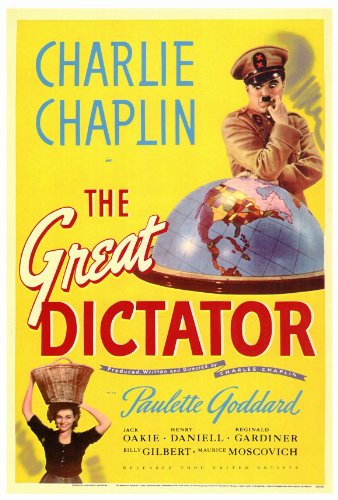The Great Dictator, starring Charlie Chaplin, Paulette Goddard, Jack Oakie, Reginald Gardiner, Henry Daniell, Billy Gilbert
The Great Dictator, possibly the most well-known of Charlie Chaplin’s films, was a timely satire on Nazisim and fascism in general, and Adolph Hitler in particular. In it, Charlie Chaplin plays a double role — Adenoid Hynkel, autocratic dictator of Tomania who blames the Jewish people for all of society’s ills, and a Jewish Barber who happens to be the spitting image of Hynkel. Contrary to what some people believe, the Jewish Barber was not Chaplin’s world-famous tramp character, although they clearly share some of the same traits. The film is a true classic, with the famous “dance with the globe” where Hynkel dances with an oversized inflated image of the globe, fantasizing about his eventual conquests. The film ends with the famous “Look Up, Hannah” speech which is, perhaps, both verbose and even hokey, but it fits properly and plays well.
I rate it 4 clowns on a 5-clown scale.
Editor’s note: originally published at Famous Clowns, used with permission
Editorial review of The Great Dictator, starring Charlie Chaplin, Paulette Goddard, Jackie Oakie, Billy Gilbert, courtesy of Amazon.com

Since Adolf Hitler had the audacity to borrow his mustache from the most famous celebrity in the world — Charlie Chaplin — it meant Hitler was fair game for Chaplin’s comedy. (Strangely, the two men were born within four days of each other.) The Great Dictator, conceived in the late thirties but not released until 1940, when Hitler’s war was raging across Europe, is the film that skewered the tyrant. Chaplin plays both Adenoid Hynkel, the power-mad ruler of Tomania, and a humble Jewish barber suffering under the dictator’s rule.
Paulette Goddard, Chaplin’s wife at the time, plays the barber’s beloved; and the rotund comedian Jack Oakie turns in a weirdly accurate burlesque of Mussolini, as a bellowing fellow dictator named Benzino Napaloni, Dictator of Bacteria. Chaplin himself hits one of his highest moments in the amazing sequence where he performs a dance of love with a large inflated globe of the world. Never has the hunger for world domination been more rhapsodically expressed.
The slapstick is swift and sharp, but it was not enough for Chaplin. He ends the film with the barber’s six-minute speech calling for peace and prophesying a hopeful future for troubled mankind. Some critics have always felt the monologue was out of place, but the lyricism and sheer humanity of it are still stirring. This was the last appearance of Chaplin’s Little Tramp character, and not coincidentally it was his first all-talking picture. — Robert Horton — This text refers to the VHS Tape edition.
Funny movie quotes from The Great Dictator
You can read the final speech from The Great Dictator, known as Look Up, Hannah
Trivia about The Great Dictator:
- Charlie Chaplin got the idea when a friend, Alexander Korda, noted that his screen persona and Adolf Hitler looked somewhat similar. Chaplin later learned they were both born within a week of each other, roughly the same height and weight and both struggled in poverty until they reached great success in their respective fields. When Chaplin learned of Hitler’s policies of racial oppression and nationalist aggression, he acted this similarity as an inspiration to attack Hitler on film.
- Charlie Chaplin stated that had he known the true extent of the Nazi atrocities, he “could not have made fun of their homicidal insanity.”
- Production on the film started in 1937, when not nearly as many people believed Nazism was a menace as was the case when it was released in 1940.
- The German spoken by the dictator is complete nonsense. The language in which the shop signs, posters, etc in the “Jewish” quarter are written is Esperanto, a language created in 1887 by Dr L.L. Zamenhof, a Polish Jew.
- The scene where Chaplin dances with a globe had its origins in a 1928 home movie in which Chaplin also toyed with a globe in similar fashion.
- In Spain, the film was banned until dictator Francisco Franco died, in 1975.
- Chaplin said wearing Hynkel’s costume made him feel more aggressive, and those close to him remember him being more difficult to work with on days he was shooting as Hynkel.
- Chaplin named Paulette Goddard’s character after his mother, Hannah Chaplin.
- Chaplin accepted an invitation to perform the movie’s climactic speech on national radio.